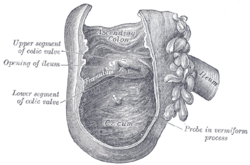Ileocecal valve
Sphincter muscle valve From Wikipedia, the free encyclopedia
The ileocecal valve[a] is a sphincter muscle valve that separates the small intestine and the large intestine.[1] Its critical function is to limit the reflux of colonic contents into the ileum.[2] Approximately two liters of fluid enters the colon daily through the ileocecal valve.
| Ileocecal valve | |
|---|---|
 Interior of the cecum and lower end of ascending colon with the ileocecal valve labeled as "colic valve" | |
 Endoscopic image of cecum with arrow pointing to ileocecal valve in foreground | |
| Details | |
| System | Digestive system |
| Location | Junction between ileum and cecum |
| Artery | Ileocolic artery |
| Vein | Ileocolic vein |
| Function | Muscular sphincter |
| Identifiers | |
| Latin | valva ileocaecalis s. papilla ilealis |
| MeSH | D007080 |
| FMA | 15973 |
| Anatomical terminology | |
Microanatomy
The histology of the ileocecal valve shows an abrupt change from a villous mucosa pattern of the ileum to a more colonic mucosa. A thickening of the muscularis mucosa,[citation needed] which is the smooth muscle tissue found beneath the mucosal layer of the digestive tract. A thickening of the muscularis externa is also noted.[1]
There is also a variable amount of lymphatic tissue found at the valve.[3]
The ileocecal valve has a papillose structure.
Clinical significance
Colonoscopy
During colonoscopy, the ileocecal valve is used, along with the appendiceal orifice, in the identification of the cecum. This is important as it indicates that a complete colonoscopy has been performed. The ileocecal valve is typically located on the last fold before entry into the cecum and can be located from the direction of curvature of the appendiceal orifice, in what is known as the bow and arrow sign.[4]
Intubation of the ileocecal valve is typically performed in colonoscopy to evaluate the distal, or lowest, part of the ileum. Small bowel endoscopy can also be performed by double-balloon enteroscopy through intubation of the ileocecal valve.[5]
Lesions
Tumors of the ileocecal valve are rare, but have been reported in the literature.[6][7] Other benign lesions may also occur on the ileocecal valve, which are often hard to diagnose and treat surgically.[8]
History
The ileocecal valve was described by the Dutch physician Nicolaes Tulp (1593–1674), and thus it is sometimes known as Tulp's valve.
The ileocecal valve was also described in 1588 by Gaspard Bauhin—hence the name Bauhin's Valve or Valve of Bauhin—in the preface of his first writing, De corporis humani partibus externis tractatus, hactenus non editus.
Additional images
- Ileum, cecum and ascending colon
- Cecum and ileum
- Ileo-cecal valve
- Ileo-cecal valve
References
External links
Wikiwand - on
Seamless Wikipedia browsing. On steroids.




